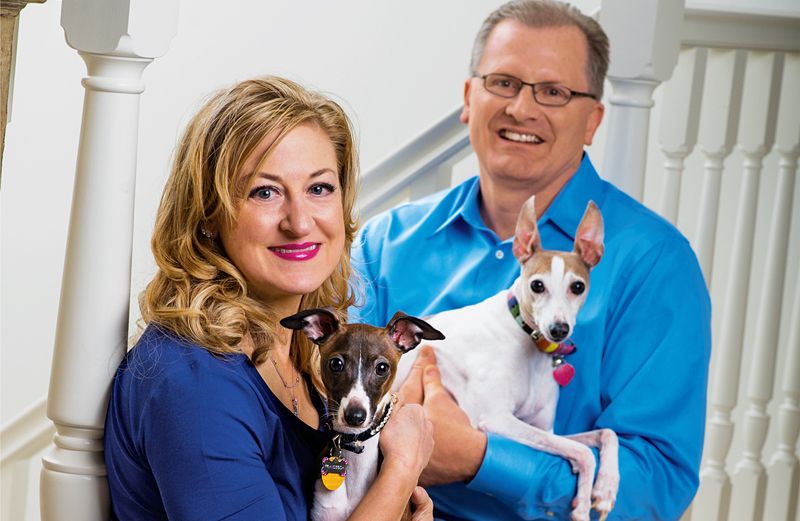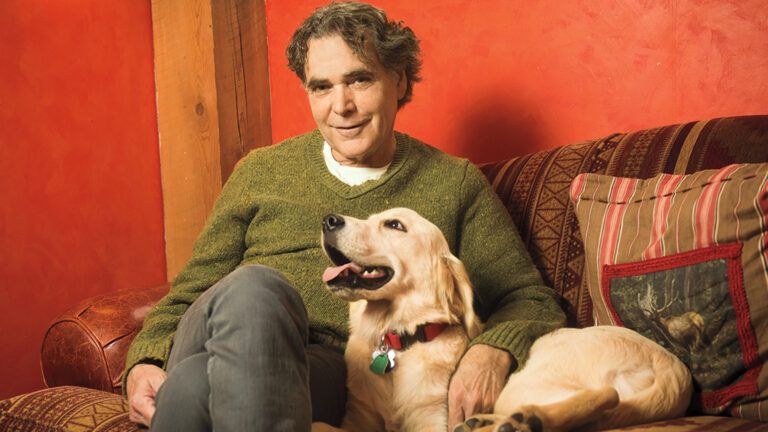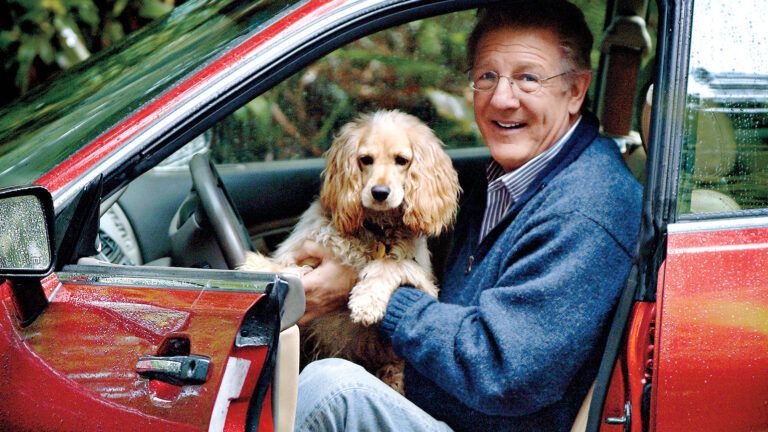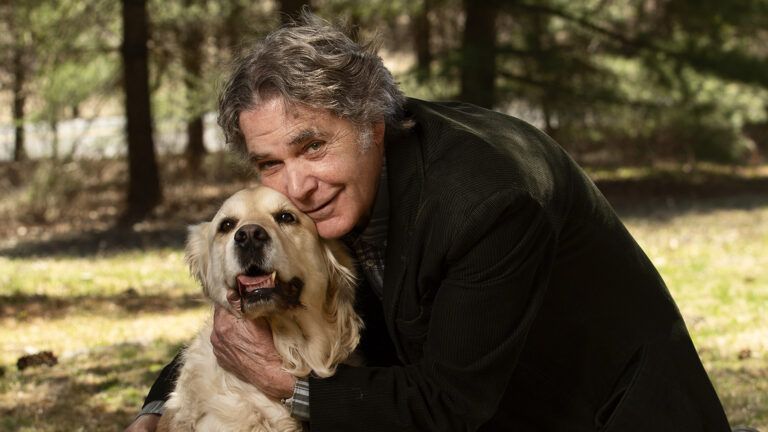Dr. Lukens’s voice was gentle but his words were crushing. “There’s nothing more we can do for Vinny,” our veterinarian said. “His body isn’t responding to the insulin, but if we continue to increase his units, he will die.”
I couldn’t even look at my husband, Kameron. I knew if I did, I’d break down. And I didn’t want Vinny, our nine-year-old Italian greyhound, to panic. He’d already been through so much, and of all our dogs, he was the most sensitive to people’s feelings, especially mine.
Fighting to remain calm, I held Vinny and stroked his side. His ribs jutted out. Even for a slender breed, he was too thin. Dangerously thin.
Because of his diabetes. More to the point, because we couldn’t find a way to manage his diabetes. I’d first noticed something was wrong eight months earlier.
Vinny was going out more often to urinate, and he started eating ravenously and drinking more too. One day he lapped up two bowls of water in less than five minutes. Despite his increased appetite, he was losing weight. “I think it might be diabetes,” Kameron said. “My dad had the same symptoms.”
We took Vinny to the vet for tests. “It’s rare in Italian greyhounds,” Dr. Lukens said, “but Vinny has diabetes mellitus.” I’d been prepared for the diagnosis because of Kameron’s suspicions. Still, I gasped. It was a shock to actually hear the words.
Dr. Lukens reassured me. It was less complicated to manage diabetes in a dog than in a human, he said. A big part of controlling diabetes is controlling diet, and owners control what their dogs eat. Unlike humans, dogs can’t usually cheat on their diets.
“You’ll have to make some changes, but Vinny can lead a full, healthy life.” Kameron was confident too. “I did a ton of reading about diabetes to help my dad,” he reminded me. “I know we can help Vinny.”
Taking care of a dog with diabetes means establishing a consistent routine–the key to keeping blood-sugar levels stable, Dr. Lukens told us–and that’s what we did for Vinny. Insulin injections twice a day, the same time every day. Meals with the same type and amount of food at the same time every day.
We rejiggered our schedules to make sure one of us was always there for Vinny–when he needed insulin, when he needed to be fed, when he needed to go out. We run our own financial-planning business, so we had some flexibility.
Kameron took the toughest shifts, taking Vinny out at 1:00 a.m., then getting up again at 5:00 to give him his first shot of insulin.
We went back and forth to the vet to check his bloodsugar readings and adjust his insulin dosage. Dr. Lukens had told us it might take some time–weeks, even–to figure out the right dosage for Vinny. But months went by, and his health got worse. He dropped from 21 to 14 pounds.
He was drinking two gallons of water a day–his body’s attempt to get rid of excess sugar–but was so dehydrated that if I tugged his skin, it remained tented.
He was up to 14 units of insulin a day, yet his blood-sugar levels skyrocketed to 394–way out of the normal range of 80 to 110. That, in turn, led to cataracts and blindness. The saddest thing was watching our energetic little dog grow listless and lethargic, as if he’d lost all his joy in life.
“I’m sorry,” Dr. Lukens told us now. “I wish there was some resolution for Vinny’s condition. Just try to keep him as comfortable as you can for as long as you can.” How long will that be? I wondered. I couldn’t bring myself to ask.
That evening we settled on the couch after dinner, Vinny resting in my lap and our other dog, Leo, snuggled beside Kameron. When Vinny licked my hand weakly, I couldn’t hold back my emotions any longer. Tears coursed down my cheeks.
“Kameron, you’ve got to do something,” I pleaded, though I knew it was hopeless. We’d exhausted all treatment options.
Even Kameron, who never seems to run out of ideas–in our 19 years of marriage, he’d come up with some that were really out there–was at his wit’s end. “I just don’t think I can handle losing him.”
Kameron looked at me, his eyes sad behind his glasses. Yet there was something else in his gaze. Determination. “Let’s not go there yet,” he said. He took my hand. “God, help us save Vinny,” he prayed. “If there’s anything we haven’t tried yet, open our minds to it.”
Kameron slept like a baby that night. Me, I lay awake, replaying Dr. Lukens’s words in my head. There’s nothing more we can do for Vinny…he will die…
Too little insulin and his body wouldn’t be able to break down food and convert it to energy at all and he would die. Too much, and he’d have seizures, lapse into a coma and die.
I couldn’t imagine life without Vinny. He was my canine soul mate–sweet, patient and so responsive. I’d trained him to recognize all the toys in his basket by name. Not only would he bring me the right toy when asked, he’d put it back!
And he was so compassionate. If Kameron or I or anyone else he loved was feeling down, Vinny would nudge his little nose against their cheek, his way of letting them know everything would be okay. I’d never needed one of his nose-nudges more…
The next morning, when I woke up, Kameron was scribbling in the notepad he keeps on his nightstand. He was so focused he didn’t notice me stir.
“What are you writing?” I asked.
Kameron looked up. His eyes were gleaming with excitement. “I woke up and it was all clear to me,” he said. He ripped the top sheet off the notepad and showed it to me.
“What is this?” I asked.
“It’s a recipe that I think can help Vinny,” he said. Somehow the list of ingredients had formed in his mind while he was asleep and he was trying to write them all down.
Kameron isn’t exactly a chef. I’m the one who does most of the cooking. But I went with it–that’s what I’ve learned to do when he’s in the grip of one of his quirky ideas.
He spent the morning scouring health-food stores getting the all-natural items on his list. When he got home, he headed straight for the kitchen.
Vinny was lying on his bed in the living room, too weak to move. I scooped him up and held him close. “Dad’s working on something for you,” I whispered.
Kameron was in the kitchen for an hour or so mixing ingredients. He emerged with his concoction. I peeked in the bowl, not sure what to make of it. “I know this doesn’t look like much,” he said. “But let’s see if he’ll take some.”
Vinny was a picky eater even in the best of times. When Kameron fed him a little of his new recipe, though, he ate it all and nosed around for more.
“Wow, he really likes it!” I said.
There didn’t seem to be any ill effects, so we continued to give Vinny the formula, along with his insulin and regular food.
A few days later, we noticed that Vinny wasn’t drinking as much water. He had a spring in his step again. He even played with Leo a bit.
We took him to the vet to check his blood sugar. Dr. Lukens was astounded. It was completely, inexplicably normal. “We’ll still monitor him regularly, of course,” he said, “but whatever you’re doing, keep doing it.”
Dia-Treaties, as Kameron dubbed his formula, became a part of Vinny’s daily meal plan, and it was so effective that Dr. Lukens lowered his insulin dosage to 10 units twice a day. His blood-sugar levels finally stabilized.
In three months, Vinny was back up to 20 pounds, and deemed healthy enough for cataract surgery. Once his vision was restored, Vinny was his old self again–as frisky as a puppy and giving Leo a run for his money.
Vinny was with us for five years beyond his diagnosis. The normal life span of Italian greyhounds tops out at 13 years, and our little guy lived to almost 15. He passed away on August 26, 2013, National Dog Day.
For Kameron and me, that was a sign that we’d been given the formula for Dia-Treaties to help not only our own dog but also other dogs with diabetes. According to scientists who are testing it in a clinical trial in the form of a nutritional bar, it could even help people with diabetes.
Now when I catch Kameron with his notepad in hand and that telltale gleam in his eye, I can’t wait to see what he’s cooked up–with divine inspiration, of course.
Download your FREE ebook, A Prayer for Every Need, by Dr. Norman Vincent Peale.




